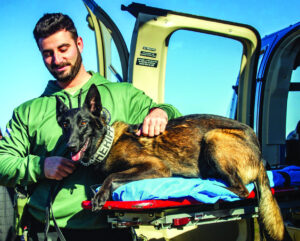Black bear spotted in Spruce Pine
SPRUCE PINE – Franklin County resident Courtney Cochran thought she was seeing things when she saw a large, black animal lumbering down the side of U.S. 43 near Spruce Pine Mountain late last week.
Cochran was heading to work when she thought she saw a bear emerge from the woods, so she put on her hazard lights to pull over. When she did, Alabama Bureau of Investigation officer Cpl. Rodney Knight, who was also headed to work, saw her and stopped to help.
“When I pulled up she asked me if I had seen the bear, too, but I hadn’t seen anything,” Knight said, “but I told her to pull into a driveway and we’d see if it came back out.”
Knight said they sat in a residential driveway for a few minutes discussing what Cochran saw when the bear suddenly reappeared several yards in front of them.
“The bear climbed into the back of the homeowner’s truck for a minute,” Knight said. “It then started roaming around the yard and the driveway before it went back into the woods.”
Ron Eakes, the District I Wildlife Supervisor for the Alabama Division of Wildlife and Freshwater Fisheries, said a sighting like that of Cochran’s and Knight’s is extremely rare for the area.
“There are less than 200 bears known to be in Alabama,” Eakes said. “Most of those are located in the northeastern part of Alabama and down around Mobile. They rarely ever come over into Northwest Alabama.”
Eakes said his department has been tracking this particular black bear for about a week and a half and they believe it began its journey in northern Georgia or eastern Tennessee.
“Typically at two years of age, the female black bear will boot her cubs out to find homes of their own,” Eakes said. “What happens is a lot of the habitats that would be suitable for the cubs to live in are already occupied, which becomes a territory issue, so they roam to try to find a place of their own.”
Eakes said the bears will usually travel about five to 10 miles in a day until they find a place they deem as a suitable area to live.
“We’ve been tracking this bear just based on sightings people have called into our office,” he said. “We think he could be trying to head to Mississippi since they have a growing bear population in their state. If he continues to head that direction, we’ll alert Mississippi authorities so they can be aware of the situation.”
Eakes said the bear shouldn’t pose a serious threat unless provoked by human intrusion such as trying to get too close to the bear, trying to feed it, or trying to hunt it down.
“Under no circumstances should anyone feed this bear or attempt to get near it,” Eakes said. “This isn’t Teddy Ruxpin. This is a wild bear and it should be treated with the respect of a wild animal. It wouldn’t intentionally harm a human, but if it felt threatened, it could cause some serious damage.”
Eakes said many people attempt to feed wild bears by purposefully leaving food or garbage out where the bear has access to it, but while many think this is helping the bear, it is actually hurting its chance for survival.
“We’ve had bears come in and instead of people doing the smart thing, they do things like leaving their garbage out and they try to feed it table scraps,” Eakes said. “Actions like these cause bears to get into trouble when they start looking for more food and will eventually lead to the animal being put down.”
For the time being, Eakes encourages residents to keep all garbage out of the bear’s range, put up bird feeders (which bears are attracted to), don’t throw out scraps and keep a safe distance if the bear is spotted.
“This bear doesn’t have any ear tags, which means he hasn’t gotten in trouble in the past for being a nuisance, so the best thing to do is leave him alone and let him get to where he is going,” Eakes said.
He added that anyone who spots the bear can contact the Division I office at 256-353-2634 to report the sighting.







